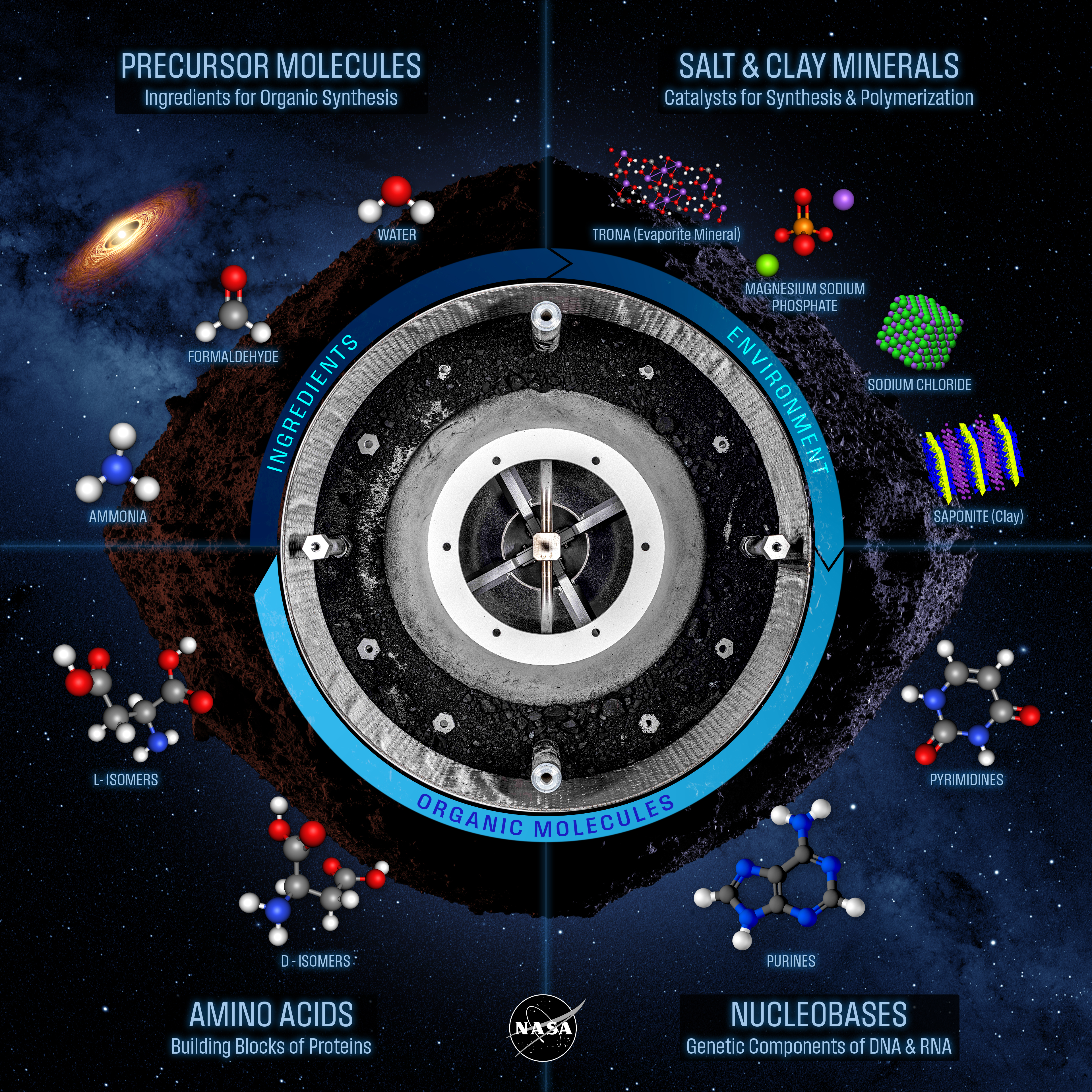In 2023, NASA’s OSIRIS-REx brought back to Earth 121 grams of material from asteroid Bennu. This is the largest sample ever collected and brought back from a world beyond the Moon. Early analysis last year suggested that this asteroid originated in a water-rich world. Newly released findings expand that further, suggesting that the conditions for the formation of life might have been more common than previously thought in the early Solar System.
ADVERTISEMENT GO AD FREE
As described in two new papers, scientists working on the samples found thousands of different organic compounds. They reported the discovery of 14 out of the 20 amino acids that make proteins in all living organisms on Earth. They also found 19 amino acids that do not make any proteins, some of which were known and rare and some even absent in known biology. They also found all five nucleobases. The four found in DNA – adenine, guanine, cytosine, thymine – as well as uracil which takes the place of thymine in RNA.
The team was quick to clarify what this does – and does not – mean for life in the universe, however. “Bennu contains many precursors to the building blocks of life. The findings do not show any evidence for life on Bennu but it shows that the conditions for life were widespread in the early Solar System,” Nicky Fox, associate administrator, Science Mission Directorate from NASA Headquarters, said in a press conference.
The team also discovered more compounds rich in nitrogen and ammonia. Ammonia in particular suggests that the parent body of Bennu was likely further away from the Sun than the asteroid it is now. Bennu is a near-Earth object (and actually the one most likely to hit Earth) but it must have formed in the colder regions of the Solar System where ammonia ice and other volatiles were stable.
“We can trust these results. The really high concentration of ammonia was surprising, this is much higher than what was found on Ryugu and in meteorites,” said Danny Glavin, senior scientist for sample return at NASA’s Goddard Space Flight Center and lead author on the new Nature Astronomy paper. “The second surprise, is we look at the chirality of the amino acids.”
Molecules can form in mirror images. Just like your left hand and right hand are mirror images of each other so certain molecules, like amino acids, can come in left-hand forms and right-hand forms.
“All life on Earth is based on the left-handed form,” Glavin continued. “Many meteorites have more than the left-handed form but we found an equal mixture of the left-handed and right-handed forms on Bennu.”
ADVERTISEMENT GO AD FREE
These findings challenge the hypothesis that the early Solar System had a bias toward the left-handed version of amino acids. The reason for this fundamental difference remains a mystery.

This figure illustrates key molecules and minerals discovered in samples of near-Earth asteroid (101955) Bennu, which were delivered to Earth by NASA’s OSIRIS-REx mission in September 2023.
Image Credit: NASA
Minerals never seen before in meteorites – where we usually learn about the composition of the early Solar System – were seen in the Bennu sample. Being able to study this precious sample is changing what we know about our little corner of the universe.
“There were things in the samples that completely blew us away. The richness of the molecules and minerals preserved are unlike any extraterrestrial samples studied before. Comparing the sample return to meteorites in our Collection, using state-of-the-art analytical facilities here in the Museum, is invaluable in helping us understand our origins,” said Prof. Sara Russell, cosmic mineralogist at the Natural History Museum, London and co-lead author of the paper published in Nature, in a statement sent to IFLScience.
ADVERTISEMENT GO AD FREE
Bennu is a carbonaceous asteroid, the most common type in the Solar System. It formed from the pieces of a water-rich parent body, whose fate is unknown. Bennu is rich in brine, salt-saturated water where many intriguing chemical reactions might have taken place. Between the organic molecules and the salty water-rich environment, Bennu had all the conditions that made it suitable for life.
“The parent body of Bennu was crammed full with these bio-essential elements, such as phosphorus,” Prof. Russell said in the press conference.
“It’s interesting that although Bennu had everything needed for life – it did not form. The complex and delicate conditions needed to catalyse life really bring into focus the abundance of biodiversity here on Earth.”
On the importance of studying early Solar System samples like this, co-lead author Tim McCoy, curator of meteorites at the Smithsonian Museum, Washington explained: “This extraordinary work, done at the scale of microns, will help us understand what happens at the scale of planets.”
ADVERTISEMENT GO AD FREE
The papers are published in the journals Nature Astronomy and Nature.
Source Link: Brine From Asteroid Bennu Reveals Conditions Suitable For Life In Early Solar System